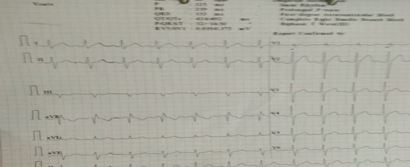Enteric Encephalopathy associated with reversible ECG changes: A Diagnostic Dilemma
Abstract
Enteric fever is common in India. It presents with various clinical manifestations. Encephalopathyand ECG changes are indicators of prognosis. Persistent ECG changes indicate a poor prognosis. Thepathogenesis of encephalopathy is unclear though prostaglandins and free oxygen species may beimplicated in the prognosis and justifies the use of steroids in enteric encephalopathy withantibiotics. The case presented here presented with encephalopathy and ECG changes whichreversed following antibiotic and steroid therapy. The importance of the case lies in the fact thattyphoid should not be missed in the diagnosis of encephalopathy and ECG should be done in allcases of enteric fever to determine the prognosis.
Downloads
References
fevers: a systematic analysis for the Global Burden of Disease Study 2017. Lancet Infect Dis
2019;19:369-81. doi: 10.1016/S1473-3099(18)30685-6 pmid: 30792131
2. Bhargava A, Ralph R, Chatterjee B, Bottieau E. Assessment and initial management of acute
undifferentiated fever in tropical and subtropical regions. BMJ 2018;363:k4766.
doi: 10.1136/bmj.k4766 pmid: 30498133
3. Ameh EA, 1999. Typhoid ileal perforation in children: a scourge
in developing countries. Ann Trop Paediatr 19: 267–272.
4. Butler T, Knight J, Nath SK, Speelman P, Roy SK, Azad MA,
1985. Typhoid fever complicated by intestinal perforation: a
persisting fatal disease requiring surgical management. Rev
Infect Dis 7: 244–256
5. Le TP, Hoffman SL, 2006. Typhoid fever. Guerrant RL, Walker
DH, Weller PF, eds. Tropical Infectious Diseases: Principles,
Pathogens and Practice, 2nd ed. Philadelphia, PA: Churchill
Livingstone.
6. Osler W, 1905. The Principles and Practice of Medicine, Designed
for the Use of Practitioners and Students of Medicine. New
York, NY: D. Appleton
7. Ali G, Rashid S, Kamli MA, Shah PA, Allaqaband GQ, 1997.
Spectrum of neuropsychiatric complications in 791 cases of
typhoid fever. Trop Med Int Health 2: 314–318.
8. Butler T, Islam A, Kabir I, Jones PK, 1991. Patterns of morbidity
and mortality in typhoid fever dependent on age and gender:
review of 552 hospitalized patients with diarrhea. Rev Infect
Dis 13: 85–90.
9. Stuart BM, Pullen RL, 1946. Typhoid; clinical analysis of 360
cases. Arch Intern Med (Chic) 78: 629–661.
10. Osuntokun BO, Bademosi O, Ogunremi K, Wright SG, 1972.
Neuropsychiatric manifestations of typhoid fever in 959
patients. Arch Neurol 27: 7–13.
11. Ali G, Rashid S, Kamli MA, Shah PA, Allaqaband GQ, 1997.
Spectrum of neuropsychiatric complications in 791 cases of
typhoid fever. Trop Med Int Health 2: 314–318.
12. Hoffman SL, Punjabi NH, Kumala S, Moechtar MA, Pulungsih
SP, Rivai AR, Rockhill RC, Woodward TE, Loedin AA, 1984.
Reduction of mortality in chloramphenicol-treated severe
typhoid fever by high-dose dexamethasone. N Engl J Med
310: 82–88.
13. Rogerson SJ, Spooner VJ, Smith TA, Richens J, 1991. Hydrocortisone
in chloramphenicol-treated severe typhoid fever in
Papua New Guinea. Trans R Soc Trop Med Hyg 85: 113–116.
14. Punjabi NH, Hoffman SL, Edman DC, Sukri N, Laughlin LW,
Pulungsih SP, Rivai AR, Sututo, Moechtar A, Woodward TE,
1988. Treatment of severe typhoid fever in children with high
dose dexamethasone. Pediatr Infect Dis J 7: 598–600.
15. Chisti MJ, Bardhan PK, Huq S, Khan WA, Khan AM,
Sharifuzzaman, Salam MA, 2009. High-dose intravenous dexamethasone
in the management of diarrheal patients with
enteric fever and encephalopathy. Southeast Asian J Trop
Med Public Health 40: 1065–1073.
16. Cooles P, 1986. Adjuvant steroids and relapse of typhoid fever.
J Trop Med Hyg 89: 229–231.
17.Daniel T.Leung et al. Factors Associated with Encephalopathy in Patients with Salmonella enterica
Serotype Typhi Bacteremia Presenting to a Diarrheal Hospital
in Dhaka, Bangladesh: Am. J. Trop. Med. Hyg., 86(4), 2012, pp. 698–702.
18. Esmailpour N, Rasoolinejad M, Abdolbaghi MH. Cardiopulmonary manifestations of
typhoid fever: A prospective analysis of 65 cases in Iran. Trop Doct 2006;36:118–19.
19. Singh S, Singhi S. Cardiovascular complications of enteric fever. Indian Pediatr
1992;29:1319–22.
20. Singh S, Gupta A, Marwaha RK. Wenckebach phenomenon and motor aphasia in
enteric fever. Indian J Pediatr 1993;60:147–9.
21. Khosla SN. The heart in enteric (typhoid) fever. J Trop Med Hyg 1981;84:125–31.

Copyright (c) 2022 Author (s). Published by Siddharth Health Research and Social Welfare Society

This work is licensed under a Creative Commons Attribution 4.0 International License.


 OAI - Open Archives Initiative
OAI - Open Archives Initiative


